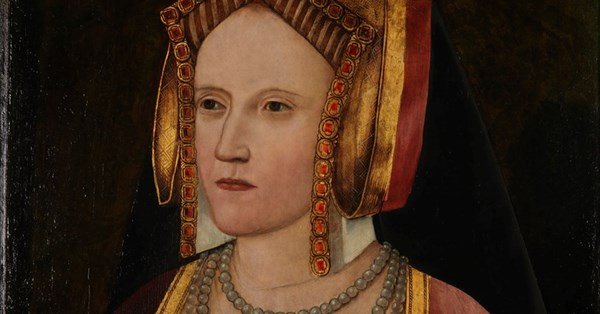A YEAR after the Princess of Wales opened the National Portrait Gallery’s refurbished redesign comes an exhibition of the kind that the Gallery does best, as it is grounded in proper scholarship. David Starkey and Roy Strong and their pupils over the past five decades have taught us much about what lies behind the Tudor courts of the 16th century.
This display concentrates on historic portraiture to examine the lives and fortunes of the women whom Henry Tudor married severally between 1509 and 1543. Something of the king’s place on the European stage can be found in his marital excursions. His first wife was the daughter of the Catholic Kings of Spain Ferdinand and Isabella, and his last, yet another former maid of honour (Catherine Parr), was a Catholic from Westmorland and his first wife’s goddaughter.
Where Catherine of Aragon lived out her days, after her royal marriage had been annulled, in Kimbolton Castle, wearing the hair shirt of the Franciscans before succumbing to cancer (January 1536), his last queen outlived him, and married again. When she was buried at Sudeley in Gloucestershire (September 1548), hers was the first Protestant funeral to be held in English.
Henry VIII in the Liverpool portrait from Hans Holbein’s workshop (c.1537) dominates the long first hall. Ignore the two rooms that lead off on the right (an alcove with 1999 Japanese fashion photos and a room with costume designs and film stills) and head straight to his imposing suit of armour made around 1540 in Greenwich. Here, in a room given to women at court, the exhibition begins in earnest, showing that six lives matter.
Tapestries were widely used in the decoration of palaces. Henry inherited an extensive collection, to which he added frequently. The one on show (Victoria and Albert Museum 338-1866) is one of no fewer than two dozen of his which depicted scenes of Esther and Ahasuerus from the Apocrypha.
 Photo Fraser Marr Photography © Private Collection, LondonPortrait of Catherine Parr (c.1547), attributed to Master John
Photo Fraser Marr Photography © Private Collection, LondonPortrait of Catherine Parr (c.1547), attributed to Master John
In January 1536, Anne Boleyn’s chaplain and almoner, John Skip (died 1552), risked preaching from the story. Few at Greenwich would have missed the allusions, as Ahasuerus had abandoned and divorced his first wife, Vashti, to marry Esther. The treachery of the wicked vizier, Haman, was a scarcely veiled attack on Thomas Cromwell, who had connived at securing Henry’s marriage to Anne and then brought about her fall. Skip avoided public censure and faithfully attended Boleyn in prison and at the scaffold, going on to be Bishop of Hereford, but the Book of Esther is not in any Anglican Sunday lectionary.
Each of Henry’s successive queens is given a room to herself, but the unmistakable impression of the one who was most regal was the Spanish princess who was known as the Dowager Princess of Wales from 1533. Little wonder that Pope Clement VII havered so long over the “king’s Great Matter”. Sebastiano del Piombo’s portrait of him, c.1531, shows him morose and resigned (Kunsthistorisches Museum, Vienna, GG 651). For my shilling, it is the finest portrait on show and undoubtedly one of the most honest of any pope.
In addition to the life-size portraits, the queens’ courts come to life with portrait miniatures by the likes of Lucas Hornebolte and Hans Holbein; and richly decorated bindings, including Catherine Howard’s stamped and gilded binding for Edward Foxe’s 1534 work on royal and ecclesiastical law, while the curators suggest that the newly widowed Catherine Parr embroidered her own crest on the cover of her copy of Petrarch. There are carved wood panels, psalters, prayer books, and Bibles.
But puzzles remain. Why, in the late-16th-century portrait said to be Anne Boleyn (NPG), does her pearl pendant bear “B” for her surname? In the period, women’s jewellery would have surely only used Christian names for such insignia. And how Protestant was Jane Seymour, whose jewels include a diamond pendant with the sacred monogram IHS, and whom a miniature has wearing a bejewelled gold tau cross. The close detail of the exhibition wants us to ask such questions.
“Six Lives: The Stories of Henry VIII’s Queens” is in the National Portrait Gallery, St Martin’s Place, London WC2, until 8 September. Phone 020 7306 0055. www.npg.org.uk









